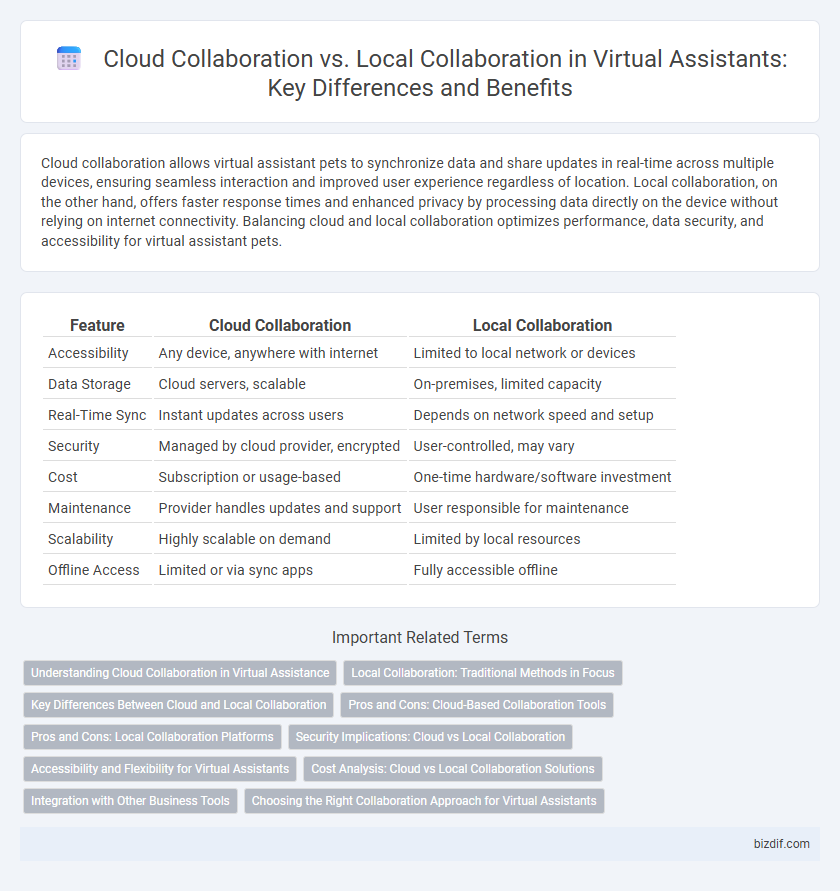Cloud collaboration allows virtual assistant pets to synchronize data and share updates in real-time across multiple devices, ensuring seamless interaction and improved user experience regardless of location. Local collaboration, on the other hand, offers faster response times and enhanced privacy by processing data directly on the device without relying on internet connectivity. Balancing cloud and local collaboration optimizes performance, data security, and accessibility for virtual assistant pets.
Table of Comparison
| Feature | Cloud Collaboration | Local Collaboration |
|---|---|---|
| Accessibility | Any device, anywhere with internet | Limited to local network or devices |
| Data Storage | Cloud servers, scalable | On-premises, limited capacity |
| Real-Time Sync | Instant updates across users | Depends on network speed and setup |
| Security | Managed by cloud provider, encrypted | User-controlled, may vary |
| Cost | Subscription or usage-based | One-time hardware/software investment |
| Maintenance | Provider handles updates and support | User responsible for maintenance |
| Scalability | Highly scalable on demand | Limited by local resources |
| Offline Access | Limited or via sync apps | Fully accessible offline |
Understanding Cloud Collaboration in Virtual Assistance
Cloud collaboration in virtual assistance leverages remote servers and internet connectivity to enable real-time access, sharing, and editing of documents and data across multiple devices and users. It enhances productivity by providing seamless integration with AI-powered tools, ensuring updates and communication occur simultaneously among distributed teams. Unlike local collaboration, cloud environments offer scalable storage, automatic backups, and secure data synchronization, optimizing workflow efficiency for virtual assistants.
Local Collaboration: Traditional Methods in Focus
Local collaboration relies on traditional methods such as in-person meetings, physical document sharing, and on-premise software, offering direct control over data and immediate interpersonal communication. While cloud collaboration enables real-time global teamwork through internet-based platforms like Google Workspace and Microsoft 365, local collaboration emphasizes security, reduced dependency on internet connectivity, and enhanced privacy by keeping data within local servers. Organizations prioritizing stringent data protection often prefer local collaboration to mitigate risks associated with cloud breaches and ensure compliance with industry regulations.
Key Differences Between Cloud and Local Collaboration
Cloud collaboration enables real-time access to shared documents and tools through internet-based platforms like Google Workspace and Microsoft 365, offering seamless updates and remote work flexibility. Local collaboration relies on in-house servers and local networks, prioritizing data security and control but limiting accessibility outside the physical location. Scalability and integration with third-party applications are stronger in cloud collaboration, whereas local collaboration may benefit from lower latency and reduced dependency on internet connectivity.
Pros and Cons: Cloud-Based Collaboration Tools
Cloud-based collaboration tools enable seamless real-time communication and file sharing across multiple devices and locations, enhancing productivity and flexibility for virtual assistant teams. However, reliance on internet connectivity and potential data security concerns can pose challenges, especially in environments with unstable networks or sensitive information. These tools offer scalable storage and automatic updates, but may involve subscription costs and data privacy trade-offs compared to local collaboration alternatives.
Pros and Cons: Local Collaboration Platforms
Local collaboration platforms offer enhanced data security by storing information on-premises, reducing reliance on internet connectivity and minimizing cloud-related vulnerabilities. They provide faster access and low latency for teams working within the same network, but may lack scalability and require higher initial costs for infrastructure setup. Limited remote access and difficulty in real-time updates pose challenges compared to cloud-based solutions.
Security Implications: Cloud vs Local Collaboration
Cloud collaboration platforms offer enhanced security features such as end-to-end encryption, multi-factor authentication, and automatic data backups, reducing the risk of data loss and unauthorized access. Local collaboration relies on internal networks and physical device security, which can limit exposure to external threats but may be vulnerable to insider risks and lacks real-time security updates. Organizations must weigh these factors against their compliance requirements and data sensitivity to determine the optimal collaboration environment.
Accessibility and Flexibility for Virtual Assistants
Cloud collaboration offers virtual assistants unparalleled accessibility by enabling seamless access to files and communication tools from any device with internet connectivity, enhancing real-time interaction and project management. Local collaboration, while limited to on-premise networks, provides controlled environments with potentially faster data transfer rates, but restricts flexibility to specific locations and devices. The scalability and integration capabilities of cloud-based solutions empower virtual assistants to adapt quickly to diverse task demands and client needs without geographic constraints.
Cost Analysis: Cloud vs Local Collaboration Solutions
Cloud collaboration solutions typically offer lower upfront costs due to subscription-based pricing and reduced need for physical infrastructure, while local collaboration requires significant investment in hardware and maintenance. Operational expenses for cloud services scale with usage, providing flexibility, whereas local systems incur fixed costs regardless of demand. Evaluating total cost of ownership reveals cloud options minimize capital expenditure but may lead to higher long-term operational fees compared to local collaboration setups.
Integration with Other Business Tools
Cloud collaboration platforms offer seamless integration with a wide range of business tools such as CRM systems, project management software, and communication apps, enabling real-time data synchronization and streamlined workflows. Local collaboration solutions typically have limited integration capabilities, often requiring manual data transfers or custom APIs to connect with other systems. Leveraging cloud-based virtual assistants enhances operational efficiency by providing unified access to various business tools within a single interface.
Choosing the Right Collaboration Approach for Virtual Assistants
Choosing the right collaboration approach for virtual assistants depends on factors such as data security, accessibility, and real-time synchronization requirements. Cloud collaboration enables seamless integration across multiple devices and locations, offering scalable storage and automated updates, which is ideal for geographically dispersed teams. Local collaboration provides enhanced control over sensitive data and lower latency, making it suitable for organizations with strict compliance standards or limited internet connectivity.
Cloud collaboration vs Local collaboration Infographic

 bizdif.com
bizdif.com